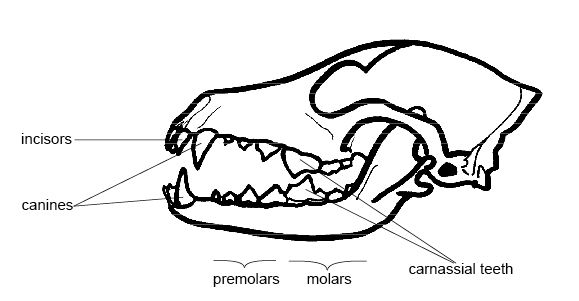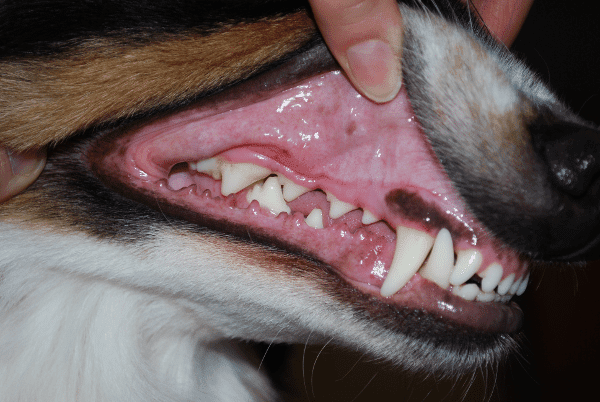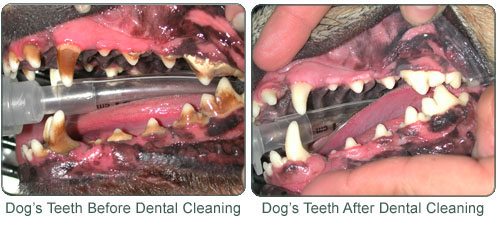Does your dog have bad breath? Are their teeth clean? We take a look at the importance of proper dental care for your dog and share some tips to help ensure their mouth stays clean and healthy.
Statistics suggest that over 80% of dogs have some degree of dental disease by the time they are 3 years old. Your dog can’t tell you when he has a toothache, so it’s essential that you take steps to keep his teeth clean. While your veterinarian does play a role in keeping your dog’s sparkly whites in good health, there is much you can do at home to prevent dental disease.
CARING FOR YOUR PUPPY’S TEETH
When you bring your new canine family member home at 8 weeks of age, he’ll have a full mouth of sharp baby teeth. There isn’t anything you need to do for these teeth, but it’s a good idea to get your pup used to having his mouth examined and his teeth cleaned. Make a game of opening his mouth, looking at his teeth and giving them a gentle rub with a soft toothbrush.
His temporary teeth will start to fall out at around 4 months of age and by 7 months he’ll have all of his permanent teeth in place. This is when you need to get serious about dental care, because these teeth need to last him for the rest of his life.
DENTAL CARE FOR ADULT DOGS
One of the first indicators that your dog’s teeth need attention is that his breath smells bad. As his dental disease progresses, he may drool and paw his mouth, and he may have trouble eating.
There are a number of things you can do to keep your dog’s teeth and gums in good condition. Bearing in mind your pet uses all his teeth for different purposes, sometimes using a combination of things works best. Not all teeth will accumulate tartar at the same rate and this can be dependent on factors like how your dog chews and whether there is good alignment of the teeth.


Canines
Dogs use their large, pointy canine teeth (fangs) at the front of the mouth for grabbing a hold of something (eg. a prey item if they were hunting, or a big bone or toy), but don’t use them for chewing. The best way to look after canines is with brushing, as these are the easiest to get to.
Incisors
There are 12 incisors in total. These are those little single-rooted teeth at the front and are mainly used for grooming and sometimes for delicate chewing (or snipping off a mouthful of grass). These are also very easy to brush and can also be kept clean with water additives.
Premolars
Behind the canines are the sharp premolars. These multi-rooted teeth are used for cutting large food items. They number 16 in total (4 on each side top and bottom). You will notice that most dogs move larger food items to the back where the cutting teeth are. The best way to keep these clean is by brushing and using a dental food or chew.
Molars
The larger 10 flat molars at the back are ideal for grinding up hard dry food. Using dental biscuits keeps these healthy and clean, they can be a bit tricky to brush since they are so far back.
What you can use to keep your pets teeth clean
Water Additives
There are various additives you can add to your pet’s drinking water that can reduce tartar formation. They do work best as a preventative, so should ideally be introduced when your dog is young or just after a dental clean. We recommend using one that has the Veterinary Oral Health Council (VOHC) seal of approval, like Healthy Mouth.
Bones and Chews
Chewing can really help to keep your pet’s teeth healthy, particularly those premolars. But we do want to recommend safe chewing. There is certainly much debate on the safety of bones in dogs and as vets we probably see the what goes wrong with bones, more than what goes right. We see countless broken, chipped and damaged teeth from dogs chewing bones. A bone that is strong enough to hold up a 1 tonne animal (cow), or even a 100kg animal (sheep) is pretty tough. And raw chicken bones are a huge choking hazard and with intensive chicken farming practices a great way to get a salmonella or e.coli infection.
The only chews that has the VOHC seal of approval are Greenies. Rawhides or pig’s ears and dehydrated chews are safer than bones, but may not do a particularly good job of cleaning teeth for many pets. Whatever your pet chews, they need to be able to sink their teeth right up to the gum line, so usually things like Kongs and Nylabones are not a good way to prevent periodontal disease (even though they are good for other reasons!).
Dental Diets
There are a number of diets now available to help prevent tartar formation. They help by mechanically brushing the teeth, as they are formed with larger pieces. They also have ingredients that help prevent gingivitis and the build-up of plaque. Your veterinarian may recommend a prescription dental diet like T/D. Dental diets are best fed as sole-diets, but there is still some benefit in mixing them in with your pet’s regular food. There are a number of diets that make claims to prevent dental disease, however to ensure they do what they say, we recommend choosing a diet from the VOHC list to ensure the claims are backed up by evidence.
Veterinary Care
If your dog is accustomed to having his mouth examined, your vet can examine his teeth every 6 months during a physical exam. It may not be possible to probe around the teeth with a dental probe to check for pockets between the tooth and gum, but your vet can assess for tartar accumulation, gingivitis and tooth fractures.
Your home care will help to prevent plaque and tartar from accumulating on your dog’s teeth but it won’t get rid of what’s already there. Even with regular brushing, as humans we need to visit the dentist every 6 months. The same goes for our pets.
A regular dental scale and polish every 6 – 12 months is the key to keeping all your pet’s teeth and avoiding unnecessary and costly dental extractions.
Once teeth have disease around the gums and significant pockets of infection around gum line, the damage to the ligaments holding the tooth in the jaw is usually irreversible, which is why sometimes teeth need to be removed. If damaged teeth aren’t removed they will just serve as a source for further infection down the track.
What does a dental involve?
When we go to the dentist we are happy to sit back in the chair, keep our mouths open and we would most likely not bite our dentist as they work. Unfortunately pets are designed a little differently, their mouths do not open as wide and even the most well behaved dog will not allow a full dental exam and clean. It is impossible to properly clean your pet’s teeth without having them under anaesthesia and safely intubated to protect their lungs from inhaling stray bits of tartar and bacteria during the clean.
When your vet cleans your pet’s teeth, the steps involved are:
- Your pet is anaesthetised and an endotracheal tube is placed to ensure no plaque, bacteria or fluid gets into your dog’s lungs.
- Each tooth and the surrounding gum is checked with specialised probe to ensure there are no deep pockets between the gum and tooth.
- Any teeth that have periodontal pockets of more than 3mm are xrayed to check the bone around the tooth.
- The teeth are scaled with an ultrasonic scaler, like what your dentist uses.
- Should any teeth be found to be unhealthy (and therefore painful) they can be removed at the same time using a local anaesthetic block, sectioning and gentle elevation to remove the tooth with minimal trauma.
- All teeth are polished to ensure the surface is smooth and less likely to attract plaque.
- Your pet is recovered from anaesthesia safely with continual nurse observation.

What happens if my pet has missing teeth?
For most dogs, they are significantly more comfortable after having diseased and damaged teeth removed. Even if all their teeth are gone, they will have no trouble eating, in fact we find most dogs have a new leasee on life once those teeth that have been aching for years have finally been treated.
Lets face it, many pets do very little chewing anyway, dogs have evolved to get that food down fast, with just the bare minimum of mastication.
Advanced dental care
Root canals and crowns are now a regular part of veterinary dental care. Perhaps pet braces are also in the future for those pets with the less-than-perfect smile.
A HEALTHY MOUTH MAKES A HEALTHY DOG
With the right home care and support from your veterinarian, your dog will enjoy a clean, healthy mouth and fresh breath. Dental care for pets has advanced significantly over the last few years and your dog can enjoy similar treatments to those available to you. The link between dental disease, kidney and heart disease has long been recognised in humans. A pet with healthy teeth has the best chance of avoiding chronic illness and living a happy, healthy life full of sweet smelling doggy kisses.



![130501-dog-tug-o-war1[1] dog tug o war](https://www.vetbabble.com/wp-content/uploads/2021/03/130501-dog-tug-o-war11-696x299.jpg)





